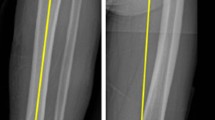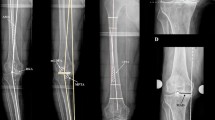Abstract
Purpose
The alignment goal in total knee arthroplasty (TKA) remains debated. Two major strategies have emerged based on recreating the native knee: kinematic and functional alignment (KA and FA). Recently a new Coronal Plane Alignment of the Knee (CPAK) classification for KA, based on bony landmarks, was described considering joint line obliquity and the arithmetic HipKneeAnkle angle (aHKA). Valgus corrected HKA medial angle (vcHKA) was measured on distractive valgus preoperative radiographs compensating for cartilage wear and ligament balance in varus osteoarthritis. The purpose of this study was to determine if aHKA accounts for differences in medial laxity for the extension gap by comparing vcHKA to aHKA. The hypothesis was that no significant difference would be observed between the two measurements.
Methods
This is a retrospective analysis of 749 knees in consecutive patients presenting to a single-centre with primary medial osteoarthritis. Patients underwent standardized weight bearing long-leg and valgus stress radiographs. Tibial mechanical angle (TMA), femoral mechanical angle (FMA) and vcHKA were measured using digital software. aHKA and vcHKA were compared to determine differences due to soft tissue balancing.
Results
The mean FMA was 91.3 ± 2.2° (range 82°–97°), the mean TMA was 85.7 ± 2.5° (range 75°–98°), the mean aHKA was 177.0 ± 3.0° (range 164°–185°) and the mean vcHKA was 176.6 ± 3.1° (range 165°–192°). No significant difference was observed between aHKA and vcHKA (p = 0.06). A significant correlation was found between vcHKA and TMA (ρ = 0.3; p < 0.001) and between vcHKA and FMA (ρ = 0.41; p < 0.001).
Conclusion
This study showed that vcHKA was similar to aHKA confirming that aHKA accounts for ligamentous medial laxity. Therefore, kinematic alignment based on the CPAK classification matches the pre-arthritic coronal alignment of the knee for the extension gap.
Level of evidence
IV.



Similar content being viewed by others
References
Ahn JH, Lee SH, Yang TY (2016) Varus-valgus stress radiograph as a predictor for extensive medial release in total knee arthroplasty. Int Orthop 40:1639–1646
Almaawi AM, Hutt JRB, Masse V, Lavigne M, Vendittoli P-A (2017) The impact of mechanical and restricted kinematic alignment on knee anatomy in total knee arthroplasty. J Arthroplasty 32:2133–2140
Bellemans J, Colyn W, Vandenneucker H, Victor J (2012) The Chitranjan Ranawat award: is neutral mechanical alignment normal for all patients? The concept of constitutional varus. Clin Orthop Relat Res 470:45–53
Blakeney W, Beaulieu Y, Kiss M-O, Rivière C, Vendittoli P-A (2019) Less gap imbalance with restricted kinematic alignment than with mechanically aligned total knee arthroplasty: simulations on 3-D bone models created from CT-scans. Acta Orthop 90:602–609
Blakeney W, Clément J, Desmeules F, Hagemeister N, Rivière C, Vendittoli P-A (2019) Kinematic alignment in total knee arthroplasty better reproduces normal gait than mechanical alignment. Knee Surg Sports Traumatol Arthrosc 27:1410–1417
Boonen B, Kerens B, Schotanus MGM, Emans P, Jong B, Kort NP (2016) Inter-observer reliability of measurements performed on digital long-leg standing radiographs and assessment of validity compared to 3D CT-scan. Knee 23:20–24
Bourne RB, Chesworth BM, Davis AM, Mahomed NN, Charron KDJ (2010) Patient satisfaction after total knee arthroplasty: who is satisfied and who is not? Clin Orthop Relat Res 468:57–63
Brouwer RW, Jakma TSC, Brouwer KH, Verhaar J a. N (2007) Pitfalls in determining knee alignment: a radiographic cadaver study. J Knee Surg 20:210–215
Freisinger GM, Schmitt LC, Wanamaker AB, Siston RA, Chaudhari AMW (2017) Tibiofemoral osteoarthritis and varus-valgus laxity. J Knee Surg 30:440–451
Gbejuade HO, White P, Hassaballa M, Porteous AJ, Robinson JR, Murray JR (2014) Do long leg supine CT scanograms correlate with weight-bearing full-length radiographs to measure lower limb coronal alignment? Knee 21:549–552
Goker B, Block JA (2007) Improved precision in quantifying knee alignment angle. Clin Orthop Relat Res 458:145–149
Graichen H, Lekkreusuwan K, Eller K, Grau T, Hirschmann MT, Scior W (2021) A single type of varus knee does not exist: morphotyping and gap analysis in varus OA. Knee Surg Sports Traumatol Arthrosc. https://doi.org/10.1007/s00167-021-06688-4
Hess S, Moser LB, Robertson EL, Behrend H, Amsler F, Iordache E, Leclercq V, Hirschmann MT (2021) Osteoarthritic and non-osteoarthritic patients show comparable coronal knee joint line orientations in a cross-sectional study based on 3D reconstructed CT images. Knee Surg Sports Traumatol Arthrosc. https://doi.org/10.1007/s00167-021-06740-3
Hirschmann MT, Karlsson J, Becker R (2018) Hot topic: alignment in total knee arthroplasty-systematic versus more individualised alignment strategies. Knee Surg Sports Traumatol Arthrosc 26:1587–1588
Hirschmann MT, Moser LB, Amsler F, Behrend H, Leclercq V, Hess S (2019) Phenotyping the knee in young non-osteoarthritic knees shows a wide distribution of femoral and tibial coronal alignment. Knee Surg Sports Traumatol Arthrosc 27:1385–1393
Howell SM, Kuznik K, Hull ML, Siston RA (2008) Results of an initial experience with custom-fit positioning total knee arthroplasty in a series of 48 patients. Orthopedics 31:857–863
Insall JN, Binazzi R, Soudry M, Mestriner LA (1985) Total knee arthroplasty. Clin Orthop Relat Res 192:13–22
Karachalios T, Komnos GA (2020) Individualized surgery in primary total knee arthroplasty. EFORT Open Rev 5:663–671
Lazennec JY, Chometon Q, Folinais D, Robbins CB, Pour AE (2017) Are advanced three-dimensional imaging studies always needed to measure the coronal knee alignment of the lower extremity? Int Orthop 41:917–924
Lee O-S, Elazab A, Lee YS (2019) Preoperative varus-valgus stress angle difference is valuable for predicting the extent of medial release in varus deformity during total knee arthroplasty. Knee Surg Relat Res 31:12–18
Lim D, Kwak D-S, Kim M, Kim S, Cho H-J, Choi JH, Koh IJ (2021) Kinematically aligned total knee arthroplasty restores more native medial collateral ligament strain than mechanically aligned total knee arthroplasty. Knee Surg Sports Traumatol Arthrosc. https://doi.org/10.1007/s00167-021-06680-y
Lonner JH, Laird MT, Stuchin SA (1996) Effect of rotation and knee flexion on radiographic alignment in total knee arthroplasties. Clin Orthop Relat Res 331:102–106
Lustig S, Sappey-Marinier E, Fary C, Servien E, Parratte S, Batailler C (2021) Personalized alignment in total knee arthroplasty: current concepts. SICOT-J 7:19
MacDessi SJ, Griffiths-Jones W, Chen DB, Griffiths-Jones S, Wood JA, Diwan AD, Harris IA (2020) Restoring the constitutional alignment with a restrictive kinematic protocol improves quantitative soft-tissue balance in total knee arthroplasty: a randomized controlled trial. Bone Joint J 102-B:117–124
MacDessi SJ, Griffiths-Jones W, Harris IA, Bellemans J, Chen DB (2021) Coronal Plane Alignment of the Knee (CPAK) classification. Bone Joint J 103-B:329–337
MacDessi SJ, Griffiths-Jones W, Harris IA, Bellemans J, Chen DB (2020) The arithmetic HKA (aHKA) predicts the constitutional alignment of the arthritic knee compared to the normal contralateral knee: a matched-pairs radiographic study. Bone Joint Open 1:339–345
McEwen PJ, Dlaska CE, Jovanovic IA, Doma K, Brandon BJ (2020) Computer-assisted kinematic and mechanical axis total knee arthroplasty: a prospective randomized controlled trial of bilateral simultaneous surgery. J Arthroplasty 35:443–450
Nam SW, Kwak JH, Kim NK, Wang IW, Lee BK (2012) Relationship between tibial bone defect and extent of medial release in total knee arthroplasty. Knee Surg Relat Res 24:146–150
Niki Y, Nagura T, Nagai K, Kobayashi S, Harato K (2018) Kinematically aligned total knee arthroplasty reduces knee adduction moment more than mechanically aligned total knee arthroplasty. Knee Surg Sports Traumatol Arthrosc 26:1629–1635
Oussedik S, Abdel MP, Victor J, Pagnano MW, Haddad FS (2020) Alignment in total knee arthroplasty. Bone Joint J 102-B:276–279
Paley D, Tetsworth K (1992) Mechanical axis deviation of the lower limbs. Preoperative planning of uniapical angular deformities of the tibia or femur. Clin Orthop Relat Res 280:48–64
Rivière C, Iranpour F, Auvinet E, Howell S, Vendittoli P-A, Cobb J, Parratte S (2017) Alignment options for total knee arthroplasty: A systematic review. Orthop Traumatol Surg Res 103:1047–1056
Sappey-Marinier E, Batailler C, Swan J, Malatray M, Cheze L, Servien E, Lustig S (2020) Primary osteoarthritic knees have more varus coronal alignment of the femur compared to young non-arthritic knees in a large cohort study. Knee Surg Sports Traumatol Arthrosc. https://doi.org/10.1007/s00167-020-06083-5
Sim JA, Kwak JH, Yang SH, Moon SH, Lee BK, Kim JY (2009) Utility of preoperative distractive stress radiograph for beginners to extent of medial release in total knee arthroplasty. Clin Orthop Surg 1:110–113
Sorin G, Pasquier G, Drumez E, Arnould A, Migaud H, Putman S (2016) Reproducibility of digital measurements of lower-limb deformity on plain radiographs and agreement with CT measurements. Orthop Traumatol Surg Res 102:423–428
Waldstein W, Schmidt-Braekling T, Perino G, Kasparek MF, Windhager R, Boettner F (2017) Valgus stress radiographs predict lateral-compartment cartilage thickness but not cartilage degeneration in varus osteoarthritis. J Arthroplasty 32:788–792
Winnock de Grave P, Luyckx T, Claeys K, Tampere T, Kellens J, Müller J, Gunst P (2020) Higher satisfaction after total knee arthroplasty using restricted inverse kinematic alignment compared to adjusted mechanical alignment. Knee Surg Sports Traumatol Arthrosc. https://doi.org/10.1007/s00167-020-06165-4
Funding
No specific grants were received from public, private for-profit and non-profit organizations for this study.
Author information
Authors and Affiliations
Corresponding author
Ethics declarations
Conflict of interest
Prof. Sébastien Lustig has performed consultancy work for Medacta, Heraeus, Corin, Amplitude, Groupe Lépine, Depuy Synthes, Smith & Nephew, Stryker. Prof. Sébastien Lustig receives institutional research support from Corin and Amplitude. Prof. Sébastien Lustig is a board member of KSSTA, Maitrise Orthopédique and JBJS american. The other authors declare that they have no conflicts of interest.
Ethical approval
The Advisory Committee on Research Information Processing in the Field of Health (CCTIRS) approved this study on June 4, 2015 under the number 135–5265. All procedures performed were in accordance with the ethical standards of the institutional and/or national research committee and with the 1964 Declaration of Helsinki and its later amendments or comparable ethical standards.
Additional information
Publisher's Note
Springer Nature remains neutral with regard to jurisdictional claims in published maps and institutional affiliations.
Rights and permissions
About this article
Cite this article
Sappey-Marinier, E., Meynard, P., Shatrov, J. et al. Kinematic alignment matches functional alignment for the extension gap: a consecutive analysis of 749 primary varus osteoarthritic knees with stress radiographs. Knee Surg Sports Traumatol Arthrosc 30, 2915–2921 (2022). https://doi.org/10.1007/s00167-021-06832-0
Received:
Accepted:
Published:
Issue Date:
DOI: https://doi.org/10.1007/s00167-021-06832-0




